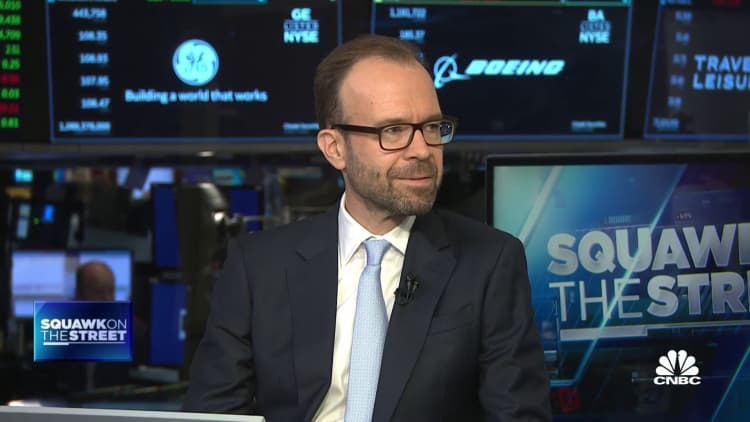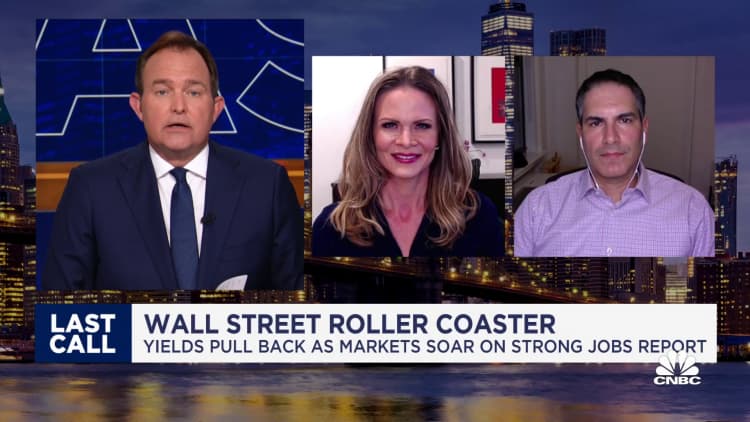From Tuesday's Dow drop to Friday's rally, here's why it was a whipsaw week for the market
The Fed is watching the jobs market closely, especially wages, as a key inflation source left to bring down, and labor data led to a big market whipsaw.

Traders work on the floor of the New York Stock Exchange during morning trading on October 04, 2023 in New York City.
Michael M. Santiago | Getty Images
When the government released September's job report Friday morning, the market's first take was that it was too good to be … good. The 10-year Treasury bond dropped nearly 2%, the stock market seemed poised to end the week adding more damage to Tuesday's 400-point Dow Jones Industrial Average drop, and the CME FedWatch tool for predicting whether the Federal Reserve will raise interest rates on Nov. 1 raised the odds of a hike by 10 percentage points.
Oops.
The S&P 500 bottomed by 10:08 a.m Eastern, and closed the day up by 1.2%. The 10-year bottomed around 10:50 a.m. and recovered about a third of its losses. And odds of another rate hike, which had edged up early in the day, had retreated again. Why? Because, despite the 336,000-job gain the Labor Department reported, there were more signs of a cooling job market in this week's data than a hot one: Crucially, a chief measure of wage inflation posted its smallest increase since June 2021, moving near a level consistent with the Fed's 2% inflation target.
"I don't think the week's data indicates the labor market needs higher interest rates," said Daniel Zhao, lead economist at career platform Glassdoor.com. "Wage growth was much cooler than expected."
First, the details. The government on Friday reported that the economy added 336,000 jobs in September, and had also added 119,000 more jobs in July and August than previously estimated. But average hourly income rose just 0.2%, doing a lot to mute fears that a tight labor market would keep propelling inflation. The reasons include higher work force participation and a growing labor force spurred, in part, by an increase in immigration this year.
The modest gain in compensation cost follows gains of 0.2% in August and 0.4% for July, which works out to an annual rate of 3.3%, if it persists in months to come, said Elizabeth Crofoot, a Washington-based senior economist at labor-analytics company Lightcast. (Year-over-year labor cost inflation was 4.2%, the lowest since mid-2021). The third-quarter climb was about the same as in 2018 and 2019, when the Fed's preferred inflation measure averaged a 1.7% gain, according to Zhao.
"You want to see around 3.5%, which is 2% inflation and 1.5% for productivity growth," Crofoot said, noting that the same index rose at about a 5% annual rate in the second quarter. "And we are close to that."
The reason wage gains can exceed the Fed's 2% inflation target is that labor costs are only part of the inflation picture, and goods prices have been declining in recent months. Durable-goods inflation, for example, is actually negative for the last year, as 2021's skyrocketing used car prices have begun to correct. So the level of wage growth the Fed wants to see, to assure that its 2% inflation target is within reach, doesn't have to get much below where it is now, Crofoot said.
The gap between economists and bond investors
Economists and bond investors have been seeing two different pictures in the labor data all week, Crofoot said.
On Tuesday, the monthly report on job openings and labor turnover, known as the JOLTS report, provoked the bears — who have pushed up treasury yields by 12% in the last month, as mortgage rates rose half a percentage point — by revealing that the economy had an estimated 9.6 million job openings at the end of August, up 690,000 from July.
But economists focused on the quits rate, or the percentage of workers who left their positions, which is considered a truer measure of how many workers made a change to pursue higher pay elsewhere. That rate was unchanged at 2.3% of workers, down 15% in the last year and back to pre-pandemic levels. The rate of layoffs was also unchanged in August at 1.1%.
The numbers that mattered the most this week are the ones that pointed to a soft landing, said Goldman Sachs chief economist Jan Hatzius. The Fed is not out to create unemployment for the sake of unemployment, Hatzius said on CNBC – its mission is to balance full employment and price stability.
That makes the new indications that price stability is within reach the more important numbers, Crofoot said. In the JOLTS report, for example, the bigger number of job openings matters less, because many of those jobs will never be filled, she said.
"It's inflation that the Fed is focused on," Hatzius said. "They don't want to create a weak economy for its own sake."

But the last week's labor data just sets the stage for inflation reports that will truly set the Fed meeting's agenda, Crofoot said.
"My best guess is that they will hold [the Fed funds rate steady]," she said. "They will wait for inflation reports.''
The Labor Department will report the consumer price index for September on Oct. 12, with economists on average predicting an increase of 0.3% monthly, or 3.6% from a year before, compared to 3.7% year-over-year inflation for August. And the Commerce Department will report the Personal Consumption Expenditures Price Index on Oct. 27. The last PCE report was a positive indicator for the Fed as far as getting inflation under control.
There are other forces at work in the bond market, including increasing fears about government spending and deficit levels, as well as worries about the risk of consumer delinquencies and corporate defaults in a higher-for-longer rate environment. But in the short-term, and last week in particular, it was the risk of the Fed placing even more pressure on the economy that resulted in a few volatile days for stocks. And a real risk remains that the Fed will raise rates too much to fight inflation, and cramp growth heading into 2024, said Bernard Baumohl, chief economist at the Economic Outlook Group in Princeton, N.J. The Federal Funds rate target range is now 5.25% to 5.5%, up from 0 to 0.25% in early 2022.
"The only threat now that could crack this resilient economy is if bond investors fear the Fed will lean toward tightening monetary policy further simply because of the exceptionally strong job numbers," Baumohl said in a note to clients, arguing that weakness in European and Chinese economies will suppress inflation through 2024. "Robust employment and declining inflation is precisely what a goldilocks economy looks like. Instead of fearing it, market investors and the Fed ought to sit back and embrace it."


 UsenB
UsenB 



















.jpg&h=630&w=1200&q=100&v=6e07dc5773&c=1)






.jpg&h=630&w=1200&q=100&v=6e07dc5773&c=1)





